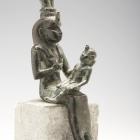The exhibition offers an interesting educational itinerary focused on some of the main aspects that characterized ancient egyptian culture.
Writing instruments and writing surfaces such as ostraca (pottery shards), papyrus, stone and wood, provide examples of the three scripts in use in ancient Egypt: hieroglyphic with its two cursive forms, hieratic and demotic.
The Pharaoh and Gods
Among the exhibits providing a traditional representation of the pharaoh - the centre of egyptian society – are firstly examples of the so-called scrolls that contained the pharaoh’s name and secondly two valuable models for sculptors, with the faces of sovereigns crowned with the uraeus (rearing cobra), from the beginning of the Ptolemaic period (4th – 3rd century BC).
Numerous bronze statues and some animal mummies accurately exemplify the different possible forms that the Egyptians attributed to their many gods.
Life after death
Present in the collection is also a large collection of objects related to funerary equipment, that ensure the survival of the deceased in the afterlife: amulets, stone and faience (glazed siliceous paste); mummiform figurines (ushabty) in a variety of sizes and materials (wood, stone and faience); canopic jars, the four containers to protect the liver, lungs, stomach and intestines of the deceased, made of different materials.
Sarcophagi (anthropomorphic and rectangular) in painted wood, among which we note the series from Thebes, including the Peftjauyuayset grave goods, together with the mummy, and a second male mummy (Busca mummy). There are several examples of the so-called Book of the Dead, a collection of magical ritualistic spells that accompanied the deceased on the journey to the afterlife: of particularly fine workmanship, although incomplete, is the hieratic manuscript, which belonged to Hornefer a priest who lived in the 4th century BC.
The Achille Vogliano excavation
The pride of Milan’s egyptian collection are the materials from the excavations carried out in Fayum, between 1934 and 1939, by the papyrologist Achille Vogliano on behalf of the State University (formerly the Royal University) of Milan and the Archaeological Museum. Numerous objects of daily life, mostly wooden utensils, toiletry items and children’s toys came from the excavation of part of the Hellenistic settlement of Tebtynis. The excavation of Medînet Mâdi focused instead on the sacred area, at the centre of which Vogliano brought to light a temple founded in the Middle Kingdom and expanded in the Ptolemaic era. In the ruins of the temple, its architectural decorations and votive material, Vogliano discovered the statue of its founder, the Pharaoh Amenemhat III (circa 1853-1805 BC).








